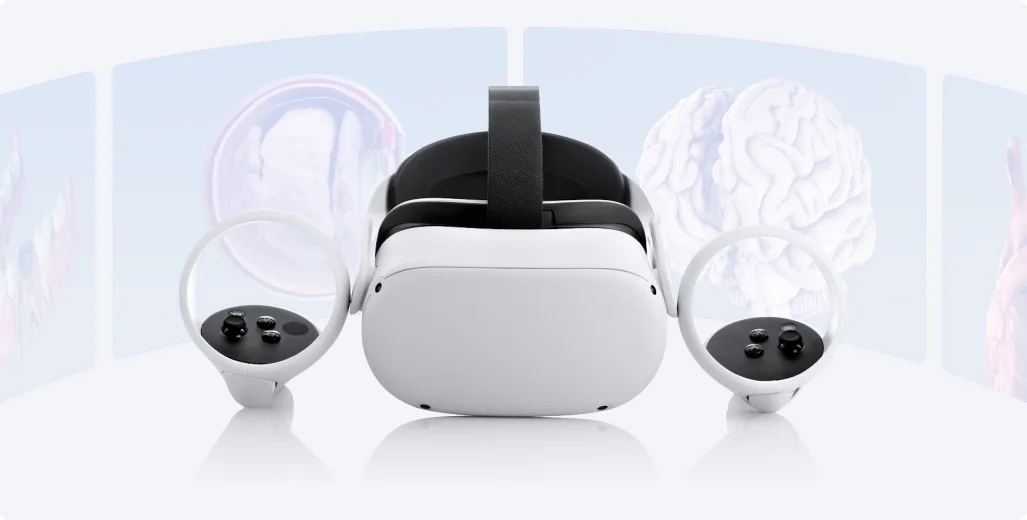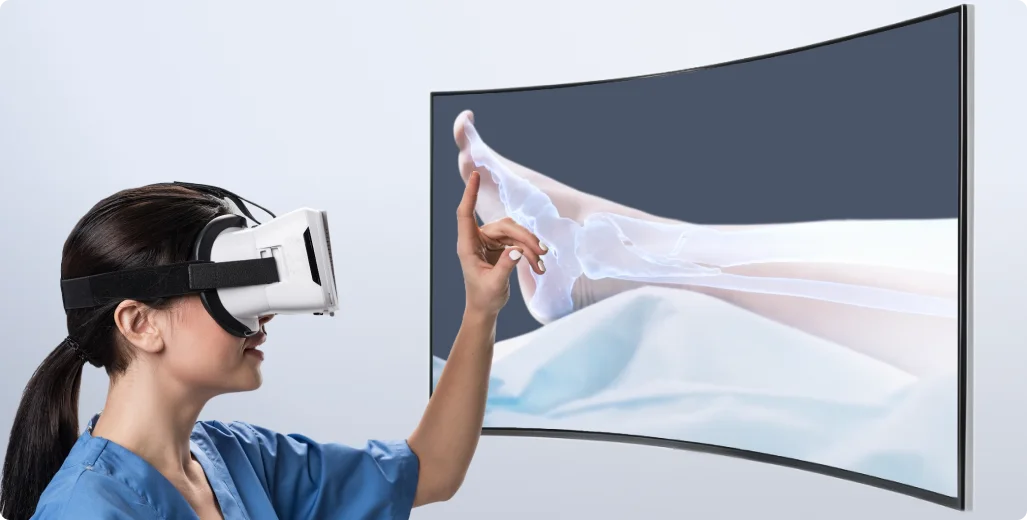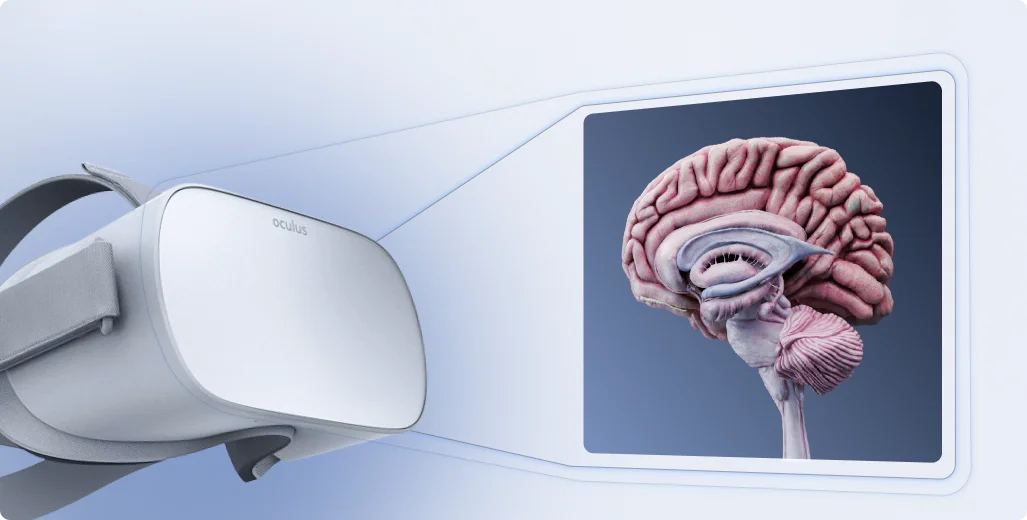
14 Benefits of VR in the Healthcare industry

Table of contents
The healthcare industry is experiencing a remarkable tech leap, and virtual reality (VR) plays a vital role in that process. In fact, healthcare VR is no longer a futuristic concept. It reshapes the way healthcare professionals are trained and patients recover. In this article, we’ll explore the key benefits of virtual reality in medicine. Let’s dive in!
How is VR used in healthcare?
Virtual reality offers innovative solutions to age-old challenges. By creating immersive virtual environments, virtual reality impacts a wide range of medical aspects, from studying human anatomy to helping patients recover both physically and mentally.
Here are the key applications of VR in healthcare:
Medical training and surgery simulations
Diagnostics and interpreting medical scans
Physical rehabilitation and pain management
Mental health therapy
Telemedicine and remote consultations
Patient education and engagement
As you see, virtual reality changes traditional healthcare methods and opens new possibilities for more advanced medical treatment.
Benefits of VR technology in healthcare

For doctors, patients, and students alike, VR technology offers a lot of opportunities. Let’s discuss VR technology in healthcare in more detail:
Benefits of VR for doctors
Improved precision and outcomes
VR use in healthcare is taking surgical planning to the next level. With patient-specific 3D anatomy models, doctors can explore every angle of a patient’s anatomy and identify potential risks. This personalized level of detail allows surgeons to plan with exceptional precision and increase surgical efficiency.
According to various estimates, VR training helps doctors complete surgeries 20% faster. Quicker surgeries not only mean less time under anesthesia for patients but also streamlined recovery times.
Skill development
One of the most significant advantages of VR healthcare training is the opportunity to practice in a stress-free setting. Healthcare professionals can master their methods, prepare for delicate operations, and simulate high-pressure situations.
Additionally, VR allows medical experts to explore and study pathological conditions in unprecedented detail. They can interact with 3D models of diseases or complex anatomical structures through specialized medical software, gaining deeper insights that are hard to achieve with traditional methods. At this point, VR helps medical experts build confidence and ensure they are ready for sudden complications.
Collaborative capabilities
When it comes to teamwork, VR removes geographical barriers by creating a shared virtual space where specialists, no matter where they are, can work side by side in real time. Say, a surgeon in New York and a radiologist in Tokyo can analyze a patient’s condition together, discussing treatment plans as if they were in the same room.
VR also allows teams to conduct surgical training and practice their roles before entering the operating room. This level of coordination is invaluable, especially for complex or high-risk procedures.
Benefits of VR for patients
Pain and stress relief
One of the health benefits virtual reality offers is reducing pain and stress for patients during medical treatments. Using immersive environments, patients can escape the discomfort of medical procedures and find themselves in calming settings, like a serene beach or a peaceful forest.
This technique, known as VR distraction therapy, is especially popular in kids’ treatment. Based on a report by the Starlight Children’s Foundation, 87% of children said they experienced little to no pain during their treatment. So, it’s not just a distraction; it’s a proven method of making difficult moments more manageable.
Rehabilitation motivation
Rehabilitation can feel repetitive and boring. That’s where VR steps in to make the process more engaging and even fun. Imagine doing physical therapy exercises while playing a game, exploring a virtual world, or accomplishing exciting challenges.
VR's ability to adapt to each patient’s needs makes it so powerful for rehab. Whether recovering from an injury, stroke, or surgery, VR programs can be personalized to target specific goals. Individuals can track their progress in real time, which adds an extra layer of patient engagement.
Mental health support
As for mental health treatment, VR is a win-win tool for both patients and therapists. VR exposure therapy (VRET) allows patients to face their fears or anxieties in a safe environment.
Whether it’s fear of flying, public speaking, or post-traumatic stress disorder (PTSD), VR lets patients gradually work through these challenges with expert guidance. Studies even show that the use of VR demonstrates success rates ranging from 66% to 90% for individuals with PTSD.
Increased accessibility
Another great perk of VR for healthcare is how it makes treatment accessible to more people. Traveling to see a specialist or attend therapy sessions can be limited for patients with mobility challenges or living in remote areas. With VR, that’s no longer a problem.
While VR does require special equipment such as headsets, ongoing advancements are making these tools helpful. Patients can connect with doctors and therapists remotely and still have personalized experiences like immersive VR consultations, rehab programs, mental health sessions, and more. This means that more people can get the care they need.
Benefits of VR for medical students
Realistic training simulations and improved confidence
Nothing beats hands-on experience, and VR simulations take medical education to the next level. Students can step into a virtual operating room to practice procedures ranging from routine surgeries to complex emergencies, all in a safe, controlled environment. This immersive practice helps them face real-world challenges without any risk to patients.
Beyond just skill-building, VR training in healthcare boosts confidence. Medical students can make decisions, refine techniques, and repeat scenarios as many times as needed, which allows them to learn from mistakes and perfect their skills. This repeated practice is essential for developing the confidence needed to transition smoothly from the classroom to actual patient care.
Dynamic learning
Learning medicine doesn’t have to mean flipping through endless textbooks or static images; VR brings a fresh approach to medical education. With 3D human body models, students can explore the human body layer by layer, zooming in on organs, tissues, and microscopic structures. While this requires access to VR headsets and compatible devices, many institutions are increasingly adopting these tools to provide hands-on experiences.
What’s even better is how customizable VR learning can be. Need to focus on the cardiovascular system? Or maybe you want to revisit a tricky procedure? Virtual reality lets you tailor your study sessions to your specific needs.
Benefits of VR for medical facilities
Cost savings
Investing in VR might sound like a big expense. But in the long run, it’s a smart, cost-effective move for medical facilities. While traditional methods, such as working with cadavers, remain essential for certain scenarios, they can be expensive to set up and maintain.
VR complements this approach and eliminates overspending by offering a reusable, scalable way to train. With just headsets and the right software, facilities can provide high-quality, scenario-based training to many staff members without the recurring costs of physical materials.
Enhanced patient care
VR can make a difference in terms of patient communication. If doctors need to help patients understand their condition, they can use a 3D visualization or walk them through a surgery plan in a virtual environment. These solutions make complex medical information easier to grasp. Plus, VR can reduce anxiety by allowing patients to “experience” procedures in a virtual setting beforehand.
Remote accessibility
One of the most significant benefits of virtual reality in healthcare is making hospital programs accessible from the comfort of home. Patients no longer need to travel long distances or navigate logistical challenges to receive care. Virtual reality enables hospitals to deliver a wide range of services remotely, including consultations, rehabilitation programs, and mental health therapy, all in an engaging and immersive format. This not only enhances convenience for patients but also allows facilities to provide consistent, high-quality care without the need for expanding physical infrastructure.
Competitive advantage
Patients always search for facilities where they can get the best possible care, and VR can help hospitals stand out. Indeed, VR creates an experience that feels modern and personalized. By integrating virtual reality into training programs, patient care, and diagnostics, clinics position themselves as leaders in the industry.
VR is also a big win for attracting top talent. Doctors, nurses, and students want to work in environments that embrace practical solutions and foster professional growth. Facilities providing VR tools for daily operations send a clear message: they invest in their staff and growth.
VR and healthcare: forecast for the future

The global impact of VR in the healthcare sector is undeniable. Experts predict the healthcare VR market will grow to $46.37 billion by 2032. So, as you see, the demand for this technology is only increasing.
Here’s what we can expect to see as VR in the healthcare industry continues to evolve:
Integration with AI and big data: VR and artificial intelligence will team up to create even more personalized care. Based on a patient’s medical history or wearable data, VR simulations can become more adaptive.
Education at all levels: VR will become a standard tool in education for medical students and specialists. We can expect more interactive courses and training sessions that cater to diverse learning styles.
Enhanced telemedicine experiences: Telemedicine is already transforming healthcare, and VR will take it further. Patients and doctors will meet in immersive virtual clinics, making remote consultations almost like in-person visits.
While no one can predict the future with 100% certainty, the potential for virtual reality in healthcare is incredibly promising. One thing’s for sure – the future of VR is bright, and it will continue to evolve.
Final thoughts on the benefits of VR in healthcare
VR is shaking up healthcare in all the best ways, bringing benefits to doctors, patients, students, and medical facilities. While virtual reality in healthcare comes with pros and cons, its potential is undeniable. As this technology continues to grow, now is the perfect time to explore what it can do for you.
If you’re ready to see healthcare VR in action, contact us so that we can bring your vision to life. At VOKA, we specialize in creating cutting-edge VR solutions tailored to the needs of medical education, training, and patient care. Let’s shape tomorrow’s healthcare together!
FAQ
1. Is VR in healthcare scientifically proven to be effective?
Yes, there is growing scientific evidence supporting the benefits of virtual reality in healthcare. Numerous studies have shown that VR can improve surgical accuracy, enhance medical training, reduce patient anxiety, and even help manage chronic pain.
2. What equipment is needed for medical VR applications?
Most medical VR solutions require a VR headset, motion controllers, and a compatible computer or console to run the software. Some advanced setups also include haptic gloves or custom simulators for specific procedures like surgery or physical therapy. The choice of equipment depends on the use case.
3. What’s the cost of implementing VR in a hospital?
The cost can vary widely based on the complexity and scale of the solution. Basic VR training platforms might start around a few thousand dollars per year, while advanced systems with custom hardware and enterprise licenses can cost upwards of $50,000 or more. However, when weighing the benefits of VR in healthcare, many institutions find the investment worthwhile.
4. What are the limitations of current medical VR technology?
While the virtual reality health benefits are significant, there are still some challenges. High costs, limited access to hardware, and the need for technical support can be barriers to adoption. Additionally, not all VR content is standardized or clinically validated. As with any tool, understanding the pros and cons of virtual reality in healthcare is key to using it effectively and responsibly.
Table of contents
Thank you for your comment!
Your comment has been submitted for moderation and will be published soon. We'll email you once it’s live.